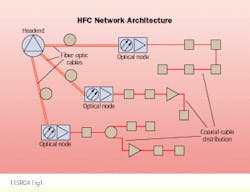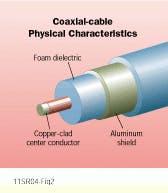The role of coaxial cable in broadband networks
To get maximum performance from coax, you must understand its characteristics.
Douglas L. Stromberg,
Telecom Training Systems Inc.
The convergence of voice, video, and data over a single infrastructure is the trend in broadband communications networks worldwide. Hybrid fiber/coaxial-cable (hfc) networks offer broadband signal capability combined with rugged performance and economy. Such networks, which can be effectively deployed in both large- and small-scale environments, use optical fiber as most of the transport medium and coaxial cable for distribution of the broadband signal to the network user. This use of coaxial cable results in levels of performance previously unheard of. It is important, therefore, for the engineer and installer to understand the critical nature of coaxial-cable characteristics.
RF transmission
Coaxial cable falls into a classification of cabling called an "RF-transmission line," which means it has special physical characteristics that allow it to efficiently transmit radio-frequency (RF) energy. It is the physical characteristics of an RF-transmission line that allow it to transport rather than radiate high-frequency signals. In the case of coaxial cable, the size and spacing of the conductors, as well as their physical symmetry, give the cable its ability to carry RF energy. Therefore, anything that disrupts the physical integrity of the coaxial cable will impair its abilities as an RF-transmission medium. The greater the bandwidth carried by this cable, the more critical these physical characteristics. This is why proper installation of the cable and connectors is critical for the performance of coaxial cable.
Because the coaxial cable in hfc networks provides so much bandwidth (up to 1 gigahertz, in some cases), it is important to evaluate how the performance of the cable varies across the spectrum. The signal loss or attenuation of a given coaxial cable is determined by three factors: resistance, dielectric material, and radiation.
Resistance in coaxial cable produces the greatest amount of attenuation per unit length. Resistance is based on the cable materials, the frequency of the transported signal, the diameter of the conductors, and the ambient temperature. As with any metallic transmission medium, the diameter of the conductors and their material will determine the resistance of the cable. hfc networks incorporate rigid coaxial cables that vary in diameter from 0.5 inch to more than 1 inch depending on the distances involved, and flexible coaxial drop cables with, typically, RG6 or RG11 diameters. The conductive materials used for the center conductor and shield are copper and aluminum, with the shield typically aluminum. In rigid cables the center conductor is copper-clad aluminum; in flexible cables it is copper-clad steel.
Due to an electrical phenomenon called "skin effect," the resistance of the conducting materials increases with the frequency being carried. This effect occurs because the current uses less of the cross-sectional area of the conductor at higher frequencies, resulting in higher attenuation at higher frequencies. The extensive bandwidth of hfc networks produces a great disparity in attenuation between the low and high frequencies of the spectrum. For example, a typical loss per hundred feet for a 1-inch rigid coaxial cable is 0.09 decibel at 5 megahertz and 1.23 dB at 750 MHz. This difference between low- and high-end losses must be corrected for by other components in the network.
Temperature also affects the attenuation of coaxial cable. Typical coaxial-cable loss varies by approximately 0.1% per degree Fahrenheit.
Cable losses are affected to a lesser degree by the material used as the cable dielectric. The function of the dielectric material in the coaxial cable is to maintain the spacing between the shield and the center conductor. Because this material is not a perfect insulator, a certain amount of signal energy is dissipated in the dielectric material itself. Lower-loss cables are achieved by using dielectric materials with better insulating properties.
All cables lose some signal energy to radiation or leakage. Because perfect cable dimensions and symmetry are not possible, there will always be a small amount of signal loss due to this characteristic. However, attenuation due to signal radiation and ingress is less of a concern than is the ability of the network to operate as a closed system. It is very important that RF signals transported over coaxial cable not be allowed to escape from the cable and cause interference to wireless services. Conversely, a leaking cable allows external signals to enter the system, where they can corrupt network signals.
The physical dimensions of a cable also affect another important factor: its characteristic impedance. In any RF-transmission system, matching the impedance of the transmission medium and the devices used in the system is critical for proper system performance. Coaxial cable used in hfc systems has a characteristic impedance of 75 ohms. If a physical impairment occurs, the impedance at that point is no longer 75 ohms, which can lead to transmission problems.
The right connections
Making connections to coaxial cable provides yet another challenge to maintaining network performance. The connector must maintain the RF characteristics as well as the characteristic impedance of the cable. Because of these requirements, cabling installers should learn correct connector installation practices. Connectors used on rigid coaxial cable are typically of a three-piece design, and special installation tools are required to install them. The popular F-type connector used on flexible coaxial cable is normally a one-piece connector that attaches to the cable using a crimp or compression procedure. Special tools are also required to install F-connectors.
In an hfc network, there must be a method for getting signals into and out of the system, as well as methods for combining and dividing signals. And all of this must be accomplished without creating excessive signal radiation or impedance mismatch. The devices designated for these purposes are called passives, because they do not require a separate power source.
The directional coupler is a three-terminal device consisting of input, output, and tap. The tap is sensitive to forward signals, and the level at the tap is directly proportional to the through signal. The tap capacity is normally given as a decibel value lower than the input signal. Depending on the tap value of the device, the coupler will have some signal loss between input and output ports. This is called the insertion loss of the device. The value (in decibels) should be given on the manufacturer`s specification sheet. The directional coupler is often used to combine signals. By using the "tap" and "out" connections as inputs and the "in" connection as an output, it is possible to combine signals onto a single cable while providing isolation between the inputs.
Signal splitters operate on the same principle as the directional coupler, except that the outputs of a splitter are equally divided. Splitters are used both on mainline cables and drop cables. The output of a two-way splitter is approximately 3.5 dB less than the input signal.
The tap is the device used to connect subscriber drops to the distribution cable. It performs the dual functions of signal division and interface of cable types. Most taps are available with a choice of 2-, 4-, or 8-drop outputs, called ports. They are available in a variety of sizes by tap value.
All the passive coaxial devices described have a frequency- response characteristic. The passband of the device varies depending on the vintage of manufacture. This variance is an important concern when broadband network services are tied to existing coaxial-cable distribution systems.
As with any communications network, the hfc system must be capable of two-way transmission. In the fiber-optic portion of the network, this capability can be achieved either by using separate transmit and receive fibers or by wavelength-division multiplexing on a common fiber. In the coaxial-cable plant, two-way signals are divided between upstream and downstream components by frequency. Many current hfc networks use a sub-split return, meaning that signals for the return path are separated from the forward path at the sub-very-high-frequency band. This technique provides downstream bandwidth from 50 MHz to as much as 1 GHz and upstream bandwidth from 5 to 50 MHz.
The downstream bandwidth is greater because these networks are designed for delivery of converged communications services. The downstream-bandwidth requirements for delivering multiple channels of digital and analog video far exceed the return-bandwidth requirements for data and telephony.
A major concern for hfc networks that deliver voice, video, and data is the entry of noise and interfering signals in the return path. Because at least part of the architecture of this network will use a tree-and-branch topology, noise buildup in the return path is a problem that must be dealt with. The use of good-quality, flexible coaxial-cable drops and connectors and the proper installation of these materials play an important role in determining network reliability.
This article is adapted from a presentation given at the BICSI Winter Conference in January 1998, in Orlando, FL.
In hybrid fiber/coaxial-cable networks, optical fiber is used from the headend to the optical node, but coaxial cable delivers the broadband signal to individual users.
Coaxial cable is constructed of a center conductor surrounded by a dielectric material and a shield, typically aluminum. The diameter of the center conductor and shield and the material of which they are constructed determine the cable`s resistance.
Douglas L. Stromberg is president of Telecom Training Systems Inc. (Wadena, MN). He can be contacted at tel: (218) 631-2746, e-mail: [email protected].


